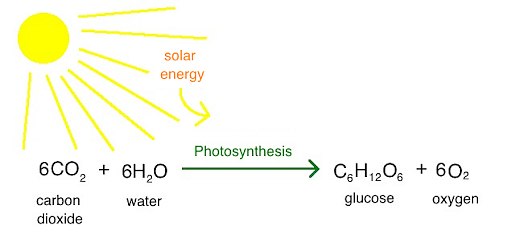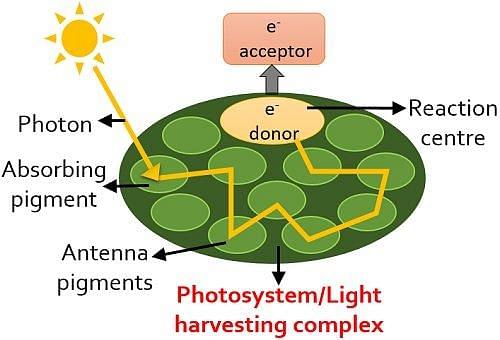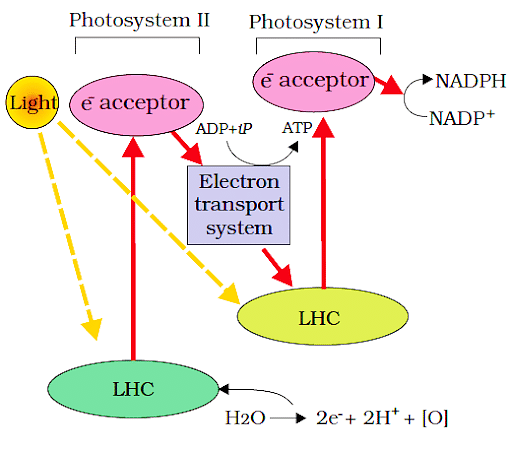
Content Curator
Photosynthesis in higher plants is the same as in smaller plants, except for some additional steps.
- Photosynthesis is the process through which plants make their food with the help of sunlight, water, and carbon dioxide.
- The by-product of photosynthesis is oxygen, which is released into the atmosphere.
- In higher plants, the main method and outcome of photosynthesis remain the same but complexity increases.
- Photosynthesis in higher plants takes place in two phases namely light reaction and dark reaction.
| Table of Content |
Key Terms: Photosynthesis, Light Reaction, Dark Reaction, Photophosphorylation, C3 Cycle, C4 Cycle, Photorespiration, Sunlight, Chloroplast
Photosynthesis
[Click Here for Sample Questions]
Photosynthesis is a physicochemical process in which plants use sunlight to produce glucose.
- Along with light energy or sunlight, Carbon dioxide and Water are the main ingredients.
- Excess glucose formed is stored as starch in the stroma of the chloroplast.
The basic reaction of photosynthesis is:

Photosynthesis Reaction
Photosynthesis in Higher Plants occurs in two main phases:
- Light Reaction
- Dark Reaction
This does not denote that dark reactions don’t require sunlight, rather they require the products formed by trapping sunlight in the light reaction. Photosynthesis takes place in the chloroplast of the mesophyll cells.
- Within the chloroplast, the inner and outer membrane, stroma lamellae, grana, and matrix stroma collect the sunlight.
- It is here that the ATP and NADPH are generated.
- In the next step, ATP and NADPH are used to produce glucose from carbon dioxide (CO2) that takes place in the stroma, also known as the kitchen of the cell.

Diagrammatic Representation of a Chloroplast
Pigments in Photosynthesis
It is often assumed that only chlorophyll traps the required sunlight for photosynthesis but in reality, there are a total of 4 pigments responsible for trapping sunlight.
- Chlorophyll a
- Chlorophyll b
- Xanthophylls
- Carotenoids
Out of these Chlorophyll a is the main pigment that attracts the majority of the sunlight.
- Chlorophyll b, Xanthophylls, and Carotenoids are called accessory pigments.
- These pigments trap light energy and complement the absorption by chlorophyll a.
- These pigments are located in the thylakoid membrane in the chloroplast.
- Each pigment traps light of different wavelengths.
- Thus, four pigments allow a wide range of lights to get trapped for photosynthesis.
Also Read:
| Related Articles | ||
|---|---|---|
| Sexual and Asexual Reproduction | Active and Passive Transport | C3 and C4 Plants |
| Transpiration | Photosynthesis and Respiration | Tissues |
Light Reaction
[Click Here for Sample Questions]
Light reaction is the process in which pigments absorb sunlight to produce energy molecules, i.e., ADP and NADPH.
- Light reaction occurs in four steps, trapping of light energy, splitting of water molecules, release of oxygen, and production of ATP and NADPH.
- The protein complexes and pigments form the LHC (Light Harvesting Complex) within Photosystem I (PS I) and Photosystem II (PS II).
- Each photosystem comprises two sections, the antennae which consist of accessory pigment and protein complexes, and the reaction center which contains a single molecule of chlorophyll a.
- In PS I the reaction center has an absorption peak at 700 nm, therefore, known as P700.
- In PS II, the reaction center has an absorption peak at 680 nm, therefore known as P680.

Photosystem/ Light Harvesting Complex
Absorption of Light
When sunlight falls on PS II, the electrons get charged up and are thrown away from the nucleus after which they are received by an electron acceptor.
- The electron acceptor transfers the received electron to the electron transport system which ultimately gives it to PS I.
- In the meantime, electrons of PS I also get charged on absorbing sunlight.
- These electrons are also transferred to a molecule of NADP+.
- On reacting with the electron NADP+ is reduced to NADPH + H+.

Diagrammatic Representation of Light Absorption
This method is also known as photophosphorylation, in which ATP is produced from ADP with the help of sunlight.
There are two types of photophosphorylation, cyclic and non-cyclic.
- In cyclic photophosphorylation, only PS I is functional and the excited electron comes back into the system.
- Here, only the production of ATP takes place.
- In the non-cyclic photophosphorylation, both photosystems are functional.
- The excited electron of PS II does not come back.
- Here, production of both ATP and NADPH + H+ occurs.
- The reaction is an example of non-cyclic photophosphorylation.
Read More: Receptors
Splitting of Water
Water is split to release oxygen, H+ ions, and electrons. These electrons are accessed by PS II to provide a continuous supply of electrons.
2H2O → 4H+ + O2 + 4e-
When PS II receives sunlight below 680nm water molecules are split, hence, splitting of water is related to PS II. This process of splitting water in the presence of sunlight is known as photolysis.
Read More: Respiration and Combustion
Dark Reaction
[Click Here for Sample Questions]
In Dark Reaction, ATP and NADPH are used to produce sugar which ultimately forms glucose or starch.
- Dark Reaction occurs in the stroma of the chloroplast.
- This is the process where the actual food of the plant i.e., starch is prepared.
- Hence, stroma is also known as the Kitchen of the Cell.
Calvin Cycle (C3 plants)
Carboxylation: Carbon dioxide reacts with ribulose-1,5-bisphosphate in the presence of RuBP carboxylase, also known as RuBisCO to form three molecules of 3-phosphoglyceric acid (3-PGA).
Reduction: Here, 2 molecules of ATP and 2 molecules of NADPH are utilized to form one molecule of glucose. ATP undergoes photophosphorylation and NADPH reduces carbon dioxide molecules to form glyceraldehyde-3-phosphate.
Regeneration: Here, RuBP or ribulose-1,5-bisphosphate is formed again so that it reacts with CO2 molecules again and the cycle continues. 6 full cycles are needed to make one molecule of glucose.

Diagrammatic Representation of Regeneration Process
Calvin Cycle (C4 Plants)
The Calvin cycle in C4 plants is also known as the Hatch and Slack Pathway. C4 plants are those plants that are habituated to live in dry tropical areas.
- Phosphoenolpyruvate (PEP) in the mesophyll cells receives carbon dioxide in the presence of PEP carboxylase or PEPcase. This results in the formation of aspartic acid and malic acid in the mesophyll cells.
- From mesophyll cells aspartic acid and malic are transferred to bundle sheath cells. In the sheath cells, these acids are broken into carbon dioxide and a 3-carbon molecule.
- The 3-carbon molecule formed is sent back to mesophyll cells where it is converted into PEP to complete the cycle.

Calvin Cycle, C4
Also Read:
| Related Articles | ||
|---|---|---|
| Mutualism | Predation | Parasitism |
| Ecology and Environment | Population | Population Interaction |
Differentiate between Light and Dark Reaction
[Click Here for Sample Questions]
Plants go through two sorts of sequential processes during photosynthesis: light reaction and dark reaction.
| Light Reaction | Dark Reaction |
|---|---|
| Needs light to occur. | Does not depend on light. |
| Leads to formation of ATP and NADPH. | Leads to formation of glucose or starch. |
| Takes place in the grana of chloroplast. | Takes place in the stroma of chloroplast. |
| CO2 fixation does not occur. | CO2 fixation occurs in both Calvin Cycles. |
| Photolysis takes place | Photolysis does not occur. |
Photorespiration
[Click Here for Sample Questions]
Photorespiration is a wasteful process in plants in which plants intake oxygen, and sunlight and release carbon dioxide and no glucose is formed.
- Photorespiration generally takes place when the concentration of oxygen in the leaves is very high and that of carbon dioxide is very low.
- Hence, the carbon dioxide fixation does not take place in the Calvin cycle.
- Hence, instead of carbon dioxide oxygen reacts with RuBP.
Things to Remember
- Photosynthesis in higher plants involves two main steps, Light Reaction and Dark Reaction.
- In light reaction light energy is collected to form ATP and NADPH whereas in dark reaction these two energy molecules are utilized to form glucose or starch.
- Four pigments responsible for trapping sunlight are Chlorophyll a, Chlorophyll b, Xanthophylls, and Carotenoids.
- The main pigment is Chlorophyll known as the reactor center and other pigments are known as accessory pigments.
- The C3 Cycle takes place in plants living in dry and sandy areas.
- Whereas the C4 Cycle is for all other photosynthetic plants. But the process in both cycles is the same.
- Calvin Cycle is named after Dr. Melvin Calvin, an American Biochemist.
Sample Questions
Ques. Which is the main pigment that traps sunlight for photosynthesis? (1 Marks)
Ans. Out of the 4 pigments, Chlorophyll a, Chlorophyll b, Xanthophylls and Carotenoids, Chlorophyll a is the main pigment. It is also the reaction centre in the Light Harvesting Complex (LHC).
Ques. Define photosynthesis with a suitable chemical equation. (2 Marks)
Ans. Photosynthesis is the process by which plants trap sunlight with chlorophyll in the presence of water and carbon dioxide from the atmosphere to form glucose and release oxygen in air. The chemical equation for the reaction is:
![]()
Ques. Can plants intake oxygen in place of carbon dioxide? If yes, then what is the process known as? (2 Marks)
Ans. During photorespiration plants take oxygen and give out carbon dioxide. This occurs when leaves have high concentration of oxygen and low concentration of carbon dioxide. Hence, the Calvin cycle takes place where instead of the CO2 molecule, the O2 molecule is fixated.
Ques. What is photophosphorylation and its types? (2 Marks)
Ans. Photophosphorylation is the photochemical process in which light energy is used to convert ADP into ATP. It is of two types, cyclic and non-cyclic.
In cyclic photophosphorylation, the electron released after exciting comes back in the system. Whereas in non-cyclic photophosphorylation, the excited electron never comes back as in case of absorption of light (light reaction).
Ques. Difference between Cyclic and Non-Cyclic Photophosphorylation. (3 Marks)
Ans.
| Cyclic Photophosphorylation | Non- Cyclic Photophosphorylation |
|---|---|
| Only Photosystem I is functional. | Both photosystems are functional. |
| Results in formation of only ATP. | Results in the formation of ATP and NADPH + H+. |
| The charged electrons return in the system. | The charged electrons of PS II do not return to the system. |
Ques. Difference between C3 and C4 Calvin Cycle. (3 Marks)
Ans.
| C3 Cycle | C4 Cycle |
|---|---|
| ribulose-1,5-bisphosphate or RuBP is the carbon acceptor. | Phosphoenolpyruvate or PEP is the carbon acceptor. |
| Takes place in mesophyll cells. | Takes place in mesophyll and bundle sheath cells. |
| Takes place in most of the plants. | Takes place in plants of dry and sandy regions. |
| Results in the formation of 3-phosphoglyceric acid. | Results in the formation of aspartic and malic acid. |
Ques. What does the law of Limiting Factors state and explain with an example? (2 Marks)
Ans. The law states, “If a chemical process is affected by more than one factor, then its rate will be determined by the factor which is nearest to its minimal value: it is the factor which directly affects the process if its quantity is changed.”
For example, if a decent amount of chlorophyll, Carbon dioxide and water is present but if adequate temperature is not achieved the photosynthesis will not take place. Not fulfilling anyone factor affects the overall process. The photosynthesis will begin as soon as the adequate temperature is achieved.
Ques. Give a labeled diagram of cyclic photophosphorylation. (2 Marks)
Ans.

Cyclic Photophosphorylation
Ques. What are the chloroplasts' functions? (2 marks)
Ans:
- The pigment in plant cells is produced by the chloroplast.
- The sunlight was caught by chloroplast and stored as energy (ATP).
- Because it creates oxygen, chloroplast plays a crucial role in the beginning of life.
- Photosynthesis is carried out by chloroplast, which is mostly found in green plants.
Ques. Plants are green because chlorophyll absorbs light for photosynthesis, but why are there so many plants with red leaves all year, and why are they red in particular? (2 marks)
Ans: Chlorophyll does not appear to be abundant in all plants. Anthocyanidins and anthocyanins are found in some. Depending on the quantities, these plant hormones are responsible for hues of blue or red. There are some plants that are completely transparent and require very little care to develop, such as the Indian pipe mushroom.
For Latest Updates on Upcoming Board Exams, Click Here: https://t.me/class_10_12_board_updates
Check-Out:





Comments